Selecting a telescope for a child
This is a bit of a delicate proposition. There are a few factors. Let me cover some points. First off, price is a definite factor. And.... the more you spend the more likely the child will have rewarding experiences with the telescope.
But the modern world has set expectations pretty high.
We all know what Saturn looks like, We all know exactly what spiral galaxies look like. And we are all pretty much spoiled by the amazing images we see of celestial objects. The high quality images are simply unreachable with an average telescope! It can be a disappointment for kids. But, the hunting and finding of celestial objects can be very rewarding and enriching.
Let me give you an example
This is saturn! We all know that! This is what we picture in our minds eye when we think of Saturn.
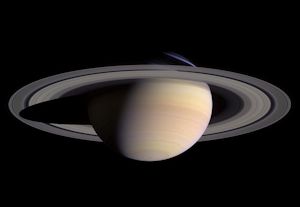
But, looking at it through a small telescope this next picture is what we see. Which is actually quite wonderful. It can lead to a bit of disappointment though. But this is the nature of astronomy. Part of the fun of it is in the exploration. Digging out the star charts, identifying constellations in the sky, tracking down saturn then finding it in the telescope. There is wonder and awe in that.
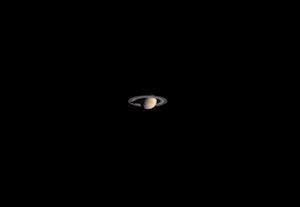
So, what do I recommend here?
I actually have a very strong recommendation. And I am going to back it up with some advice and help!
It can be a treasure hunt
First off, let's make the telescope part of a whole experience. I don't advise just getting a telescope for a child. It can be off putting and disappointing. What I do advise is getting some supporting materials to go with it. As a minimum a star chart and a moon chart. But I also say get a book or two that is written for young star gazer. This make it a richer experience.
The child will pore over the materials during the day, looking over the materials. Checking out the star charts and reading about the celestial objects.
It becomes a treasure hunt. The young astronomer orients to the constellations, finds the right area of the sky then starts peering through the telescope and moving it around to find the desired object. And with a little bit of time voila! The treasure has been found. That brings a lot of joy.
Here are six wonderful experiences you can find with a telescope.
1. The moon of course - And the smaller the phase of the moon the better. A full moon is too bright and with no shadows. A crescent moon is a wonder to view. The long shadows make the craters very prominent. Can the child identity, with the help of a moon chart, some of the major craters like Tycho?
2. Saturn and Jupiter - They aren't viewable at all times. Sometimes they are in the day sky. But if one or both are in the night sky they make for great viewing. You can make out the rings of saturn and you can often see the belts around Jupiter. But with Jupiter is something even more rewarding. It is the four Jovian satellites that revolve around Jupiter. It is the four largest moons of Jupiter. These can be seen in a row extending out from the equator. And in the course of a few hours you can see how they actually move.
M31 the Andromeda Galaxy - This is a galaxy that is visible to the naked eye - as a light patch of puffy white, kind of like a small cotton ball. But with a small telescope it can be seen as a galaxy. This is a very rewarding thing to find. It is an actual galaxy. Check your star chart to see if it is available the time of year you are viewing. It is in the constellation of Andromeda which is a summer constellation.
M13 The The Hercules Globular Cluster - This is a beautiful and round cluster of stars and it can be seen with the naked eye on clear and very dark night. It is a great view with a small telescope. It is in the constellation of Hercules which is a summer constellation.
M42 The Orion Nebula - This is a beautiful nebula which is an enormous cloud of space gas and debris. This one has some color to it. It is also visible with the naked eye. And pretty easy to find with a telescope. It is located in the constellation of Orion which is a winter constellation.
All of the above celestial objects are visible to the naked eye if you have clear and dark skies with little light pollution. So, you can often find them first by eyesight then zero in on them with a telescope.
So, let me recommend a couple of telescopes.

A note from Will: I have used a lot of telescopes. And have carefully gone over a lot of the telescopes that are advertised as being for kids. I think you probably should avoid most of them. They tend to be a disappointment. Albeit the price is low. I recommend you spend a little more money and get a telescope similar to these two -60mm lens size, tripod , yoke mount. Esay to use and decent optics. It will make for a good astronomy experience.
I like this Orion Telescope. It is very moderately priced. Orion makes good optics and I really love the materials that accompany this telescope.
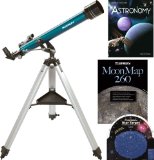
Orion Observer 60mm AZ Refractor & Starter Kit
- A great bundle for kids, the Observer 60mm Refractor & Starter Kit offers jaw-dropping views of the Moon's craters, Saturn's rings, and more!
- The Observer 60mm refractor utilizes a 60mm glass lens (not plastic) and includes two fully-coated 1.25" telescope eyepieces for two different viewing magnification options
- Included Astronomy book provides a wonderful introduction to backyard astronomy for any beginner
- Use the included Orion MoonMap 260 to find out the names of all the craters and features you see on the Moon
- Included Star Target planisphere is a round star chart you can use to see what's in the sky any day of the year
I like this celestron telescope too. You don't get quite the same accessories but you get really good optics for the price.
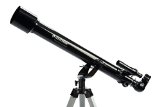
Celestron 21041 60mm PowerSeeker Telescope
Celestron's value priced PowerSeeker 60 is an affordable entry level telescope with some nice extras like a correct image prism and "The Sky" astronomy software included. The package also includes an Alt-Azimuth mount with adjustable aluminum tripod, high and low power eyepieces, a 3X barlow lens, and a 5 power cross hair finder scope.
Books
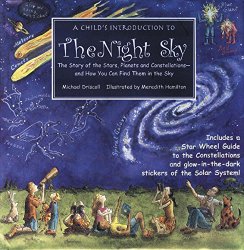
Child's Introduction to the Night Sky: The Story of the Stars, Planets, and Constellations--and How You Can Find Them in the Sky
Children eight and up will enjoy this conversational but information-packed introduction to astronomy and stargazing, which includes the achievements of the great scientists, the history of space exploration, the story of our solar system, the myths behind the constellations, and how to navigate the night sky. Whimsical color illustrations on every page and handy definitions and sidebars help engage younger readers and develop their interest. The special star wheel helps locate stars and planets from any location at any time of year. This is the third in Black Dog & Leventhal's successful series including The Story of the Orchestra and A Child's Introduction to Poetry.
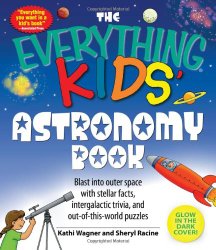
The Everything Kids' Astronomy Book: Blast into outer space with stellar facts, intergalactic trivia, and out-of-this-world puzzles
Explore the galaxies!
Aliens, space ships, and constellations, oh my! Ride on a rocket ship to another galaxy with this stellar book. With The Everything Kids' Astronomy Book , astronomers-in-training will learn:
- How galaxies like the Milky Way were built.
- Why the sun's surface is 20,000-50,000-degrees Fahrenheit.
- Why the earth spins and how gravity works.
- What comets and asteroids are made of and how they affect planets.
- The truth about the man in the moon.
- Why Mars is so hot and what those rings around Saturn are.
- What scientists think about aliens and life in outer space
If you want to build a sky-watching kit or change your room into a small universe, this book will take you on a journey that is out-of-this-world!
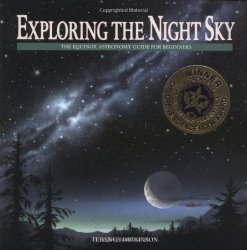
Exploring the Night Sky: The Equinox Astronomy Guide for Beginners
Exploring the Night Sky is aimed at novice star gazers anxious to expand their astronomical repertoire beyond the Big and Little Dippers. Dickinson has designed a superb introduction to astronomy that is clear, concise, beautifully illustrated, and very "user friendly" no matter what the child's age.

Do you like making projects and exploring a variety of hobbies?
Sign up for my free newsletter. I give you regular updates on hobbies and projects you can make. it is totally free and I don't share your email with anybody.
|
![]()













